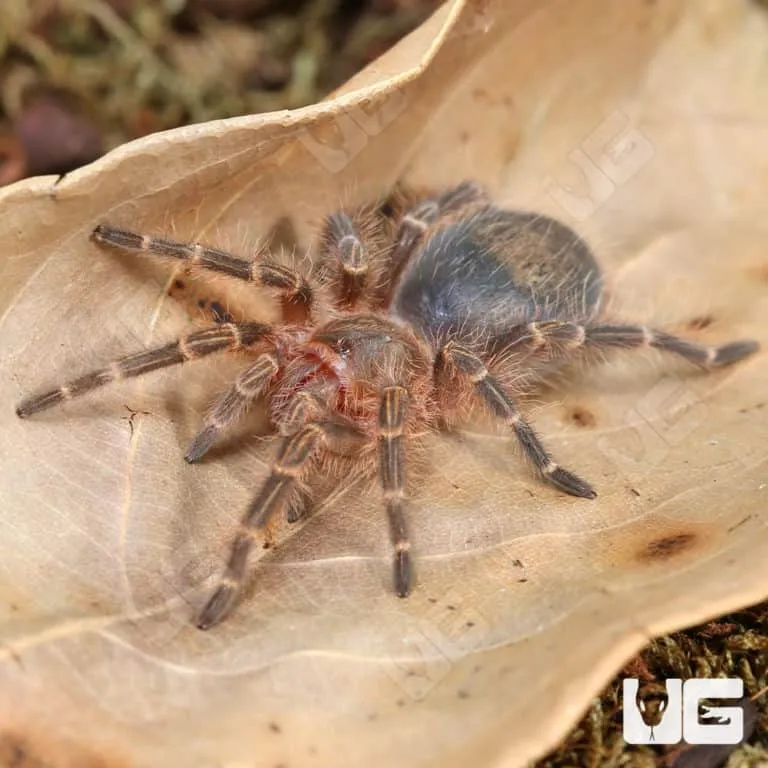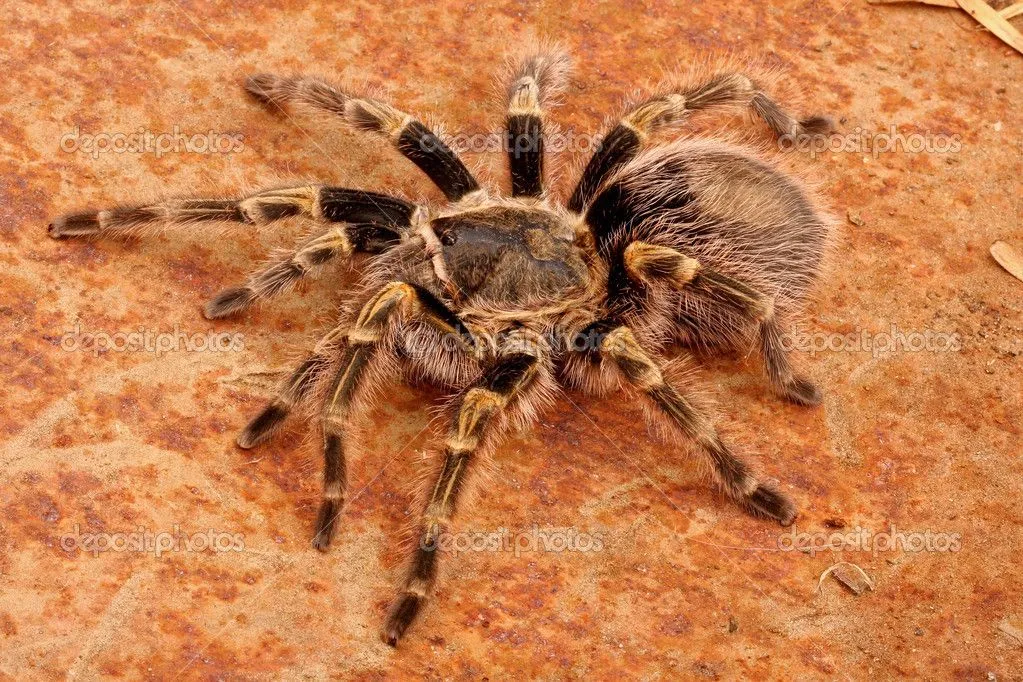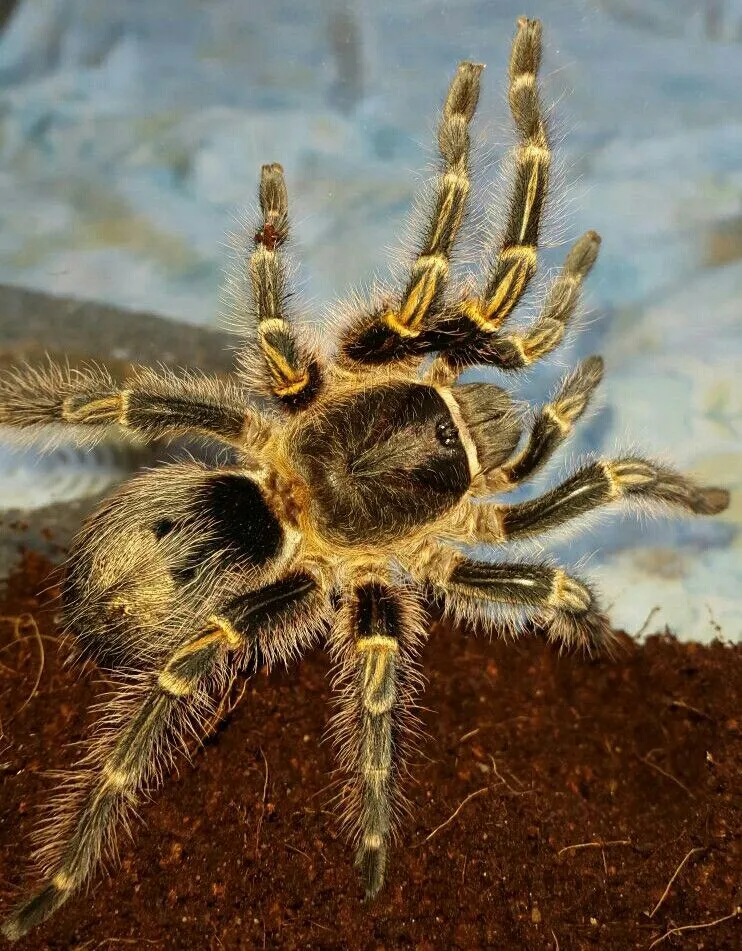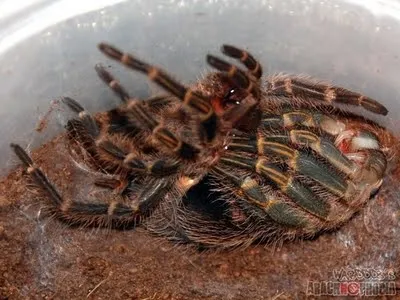What is Molting for Chaco Golden Knee Tarantulas?
Molting is a fundamental and fascinating process for Chaco Golden Knee tarantulas, and all other arthropods with exoskeletons. It’s essentially the way these creatures grow. Unlike humans and other animals with internal skeletons, tarantulas have a hard, external shell, the exoskeleton, that doesn’t grow. As a tarantula matures, it needs to shed this old, restrictive shell and replace it with a larger one. This process of shedding the old exoskeleton is called molting. It’s a vulnerable time for the tarantula, as it is soft and defenseless while the new exoskeleton hardens. Understanding the molting process is crucial for any Chaco Golden Knee owner, as it helps ensure the tarantula’s health and well-being during this critical period. Molting is a sign of a healthy and growing tarantula, and it is essential for its survival and continued development.
The Molting Process Step-by-Step
The molting process is a complex series of events, but can be broken down into a few key stages. It begins with the formation of a new exoskeleton underneath the old one. This new exoskeleton is initially soft and flexible. The tarantula will then start to separate its old exoskeleton from its body. During this phase, the tarantula will often stop eating and may become less active. The tarantula will then position itself, often on its back, and use a combination of muscle contractions and the absorption of fluids to split open the old exoskeleton. Once the old exoskeleton splits, the tarantula carefully extracts itself, a process that can take several hours. The new exoskeleton is initially soft and pale, gradually hardening over the next few days. The tarantula is incredibly vulnerable during this time, and it’s important to avoid any disturbances.
Preparing Your Tarantula for Molting

Preparing your Chaco Golden Knee tarantula for molting is a critical part of responsible pet ownership. While you can’t directly control the process, you can create the ideal environment to increase the chances of a successful molt. This involves ensuring the tarantula has a suitable enclosure, proper humidity and temperature, and is free from stress. Reduce any potential disturbances. Avoid handling your tarantula or moving its enclosure unnecessarily. Provide plenty of clean water, but don’t offer food if the tarantula is showing signs of an imminent molt, such as refusing food and becoming less active. Keep a close eye on your tarantula’s behavior and appearance. These observations will allow you to prepare adequately.
Creating the Ideal Environment
The enclosure should be appropriately sized for the tarantula, providing ample space to move around. It should also have a substrate that allows the tarantula to burrow if it chooses, which offers a sense of security and aids in the molting process. The substrate should be a few inches deep, and materials like coco fiber or a mixture of peat moss and vermiculite are ideal. Providing a hide, such as a piece of cork bark or a hollow log, gives the tarantula a safe space to retreat to before and during the molt. Maintain good ventilation to prevent the build-up of mold and maintain air quality, but avoid drafts that could dry out the enclosure. The enclosure setup should be stress-free and mimic their natural environment as closely as possible.
Humidity and Temperature
Maintaining proper humidity and temperature levels is crucial for a successful molt. Chaco Golden Knee tarantulas thrive in a moderate humidity environment, typically between 60% and 70%. You can measure the humidity using a hygrometer. Achieve this level by misting the enclosure regularly, but avoid oversaturating the substrate. Ensure proper ventilation to prevent mold growth. As for temperature, Chaco Golden Knees generally prefer temperatures between 75°F and 85°F (24°C to 29°C). A heating pad or a heat lamp can be used to maintain the correct temperature, but be sure to use a thermostat to prevent overheating. Consistent and stable humidity and temperature levels are critical for the tarantula’s overall health and for facilitating the molting process.
Providing a Safe and Secure Enclosure

A secure enclosure minimizes stress during molting. Remove anything that could potentially harm the tarantula during this vulnerable time, such as heavy decorations or items that could fall on it. Ensure the enclosure is escape-proof. Regularly check that the lid is secure. Avoid unnecessary disturbances. Place the enclosure in a quiet area away from high traffic or loud noises. During the molting process, tarantulas are incredibly sensitive. The vibrations, light, and noise can easily disrupt the process and can potentially lead to issues such as the tarantula being stuck mid-molt. By providing a secure, calm environment, you are assisting your tarantula in having a less stressful molt.
Identifying the Signs of an Imminent Molt
Recognizing the signs that your Chaco Golden Knee tarantula is about to molt allows you to adjust your care and provide the necessary support. The pre-molt phase can last from a few weeks to several months. This is variable between tarantulas. Look for changes in the tarantula’s behavior and appearance. These indicators will inform you on how to respond appropriately. Becoming familiar with these signs will help you support your tarantula.
Changes in Behavior
One of the most common signs of an upcoming molt is a change in feeding behavior. The tarantula might refuse food completely or become less interested in eating. It may also become less active and spend more time hiding in its burrow or hiding place. Some tarantulas will seal off their burrows completely. This change in behavior is a sign that the tarantula is preparing to molt and is conserving energy. Be patient, and don’t force-feed your tarantula if it is refusing food. Avoid disturbing the tarantula during this period. Just ensure there is always fresh water available.
Appearance and Physical Indicators

Physical changes are also indicators that a molt is approaching. The abdomen of the tarantula may appear darker or more swollen. You may also notice that the tarantula’s exoskeleton looks dull and less vibrant. The abdomen might appear bald. In some cases, you might be able to see the new exoskeleton forming underneath the old one, particularly on the abdomen. A tarantula in pre-molt may also become less responsive. Some Chaco Golden Knees will start creating a web mat, which they will molt on. These physical changes confirm that the molting process is imminent.
What to Do During the Molt
During the molting process, it’s crucial to minimize any disturbances. This is the time when the tarantula is most vulnerable. Avoid handling the tarantula or moving its enclosure. Maintain the correct humidity and temperature levels, but avoid misting the enclosure directly during the molt, as this could potentially disrupt the process. If the tarantula molts on its back, do not attempt to turn it over. Observe the tarantula from a distance and allow the process to occur naturally. This will help ensure a successful and stress-free molt.
Do Not Disturb
The most important thing to do during the molt is to avoid disturbing the tarantula. This means refraining from handling the tarantula, tapping on the enclosure, or making loud noises nearby. Any unnecessary disturbance can stress the tarantula and potentially interfere with the molting process. Be patient and observe from a distance. This will allow the tarantula to go through the molt without any unnecessary stress.
Handling a Post-Molt Tarantula

After a successful molt, the tarantula will be incredibly soft and vulnerable for a few days or weeks. This is when the new exoskeleton hardens. It’s important to handle the tarantula carefully or avoid handling altogether until the exoskeleton has fully hardened. You’ll notice that the tarantula’s fangs will be a bright color, and its body will gradually regain its normal coloration and firmness. Handling the tarantula too soon could injure it. Wait until the fangs have darkened again and the exoskeleton feels firm before attempting to handle your tarantula. Always be cautious and gentle.
How Long Does the Process Take?
The molting process can vary in duration depending on the tarantula’s age, size, and environmental conditions. The pre-molt phase can last for several weeks or even months. The actual molting process itself can take anywhere from a few hours to an entire day. Once the tarantula has molted, it will take a few days or weeks for the new exoskeleton to harden completely. Younger tarantulas tend to molt more frequently than older ones. The frequency of molting decreases as the tarantula grows older. Keep in mind that there are various factors that can influence the process.
Common Molting Problems and Solutions
While molting is a natural process, sometimes problems can arise. Recognizing these problems and knowing how to address them can help ensure the well-being of your Chaco Golden Knee tarantula. Some common issues are loss of limbs and stuck molts. By taking precautions and knowing what to do, you will be able to help your tarantula.
Loss of Limbs

Sometimes, a tarantula might lose a leg during the molting process. This can happen if the old exoskeleton doesn’t detach cleanly. Fortunately, tarantulas can regenerate lost limbs over several molts. Ensure the enclosure is free of any potential hazards. Keep the enclosure clean, and maintain the appropriate humidity and temperature levels. Provide a varied diet. If the tarantula has lost a limb, monitor its health and ensure it can still access food and water. Consult an experienced tarantula keeper or a veterinarian if you have concerns.
Stuck Molt
A stuck molt occurs when the tarantula is unable to completely shed its old exoskeleton. This can be a life-threatening situation. A stuck molt is often caused by low humidity or a lack of proper environmental conditions. If you notice a stuck molt, try to gently increase the humidity in the enclosure. Do not attempt to forcibly remove the old exoskeleton, as this can seriously injure the tarantula. If the tarantula is struggling, consult an experienced tarantula keeper. Consider seeking veterinary assistance. Prevention is key. Maintaining proper humidity and temperature levels will help to prevent this problem.
Feeding Your Tarantula After Molting
After molting, your Chaco Golden Knee tarantula will be extremely hungry. The new exoskeleton is soft, so it’s best to wait a few days or a week before offering food. This will allow the exoskeleton to fully harden. Once the tarantula has hardened, offer a meal of appropriately sized insects. Crickets, roaches, and mealworms are all suitable options. Start with a small meal, and observe your tarantula’s feeding behavior. The tarantula’s appetite will be increased after molting. Make sure there is fresh water available. Overfeeding the tarantula could cause it to become obese. Monitor their feeding behavior and adjust accordingly.
Diet and Nutrition
Providing a balanced diet is important for your tarantula’s overall health and for a successful molt. Feed your Chaco Golden Knee tarantula a varied diet of insects. Crickets and roaches should make up the bulk of the diet, but you can also supplement with mealworms, waxworms, and other insects. Make sure the insects you feed are gut-loaded with nutritious food before offering them to your tarantula. This will ensure that your tarantula receives the necessary vitamins and minerals. Always provide fresh water in a shallow dish. Avoid overfeeding, as this can lead to obesity.
Frequently Asked Questions about Molting
Molting can bring up numerous questions. Here are some of the most frequently asked ones, along with their answers. This will help you better understand this natural process. If your question isn’t answered, contact a knowledgeable source for assistance.
- How often do Chaco Golden Knee tarantulas molt? The frequency of molting depends on the tarantula’s age and size. Younger tarantulas molt more frequently than adults. As tarantulas mature, the intervals between molts increase.
- What should I do if my tarantula gets stuck during a molt? If your tarantula is having trouble molting, try to increase the humidity in the enclosure. Do not try to forcibly remove the old exoskeleton. If the tarantula is struggling significantly, seek advice from an expert or veterinarian.
- Is it normal for my tarantula to stop eating before a molt? Yes, it’s normal for tarantulas to stop eating before a molt. This is a sign that the tarantula is preparing for the molting process.
- How long does it take for a tarantula’s new exoskeleton to harden? It can take a few days to a few weeks for the new exoskeleton to harden completely.
- Can I handle my tarantula after it molts? Wait until the exoskeleton has fully hardened before handling your tarantula. Handling the tarantula too soon can injure it.
In conclusion, molting is a crucial process for Chaco Golden Knee tarantulas, signifying growth and development. Understanding the stages of molting, providing the right environment, and recognizing potential issues are all essential aspects of caring for these fascinating creatures. By following these guidelines, you can help ensure your Chaco Golden Knee tarantula molts successfully and thrives. Remember that patience, observation, and careful management are vital during this natural process. With proper care, you can enjoy the beauty and wonder of owning these amazing animals.
